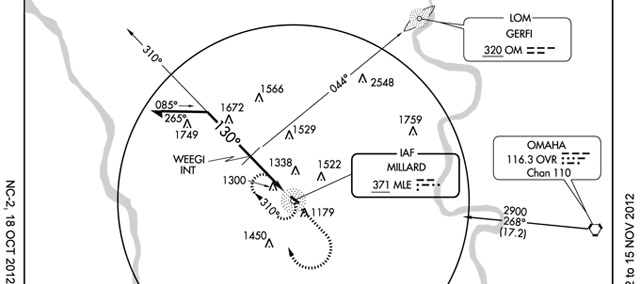
Click to view the entire diagram.
Today's instrument proficiency check promises to be invigorating—just what you need after a prolonged absence.
First, you'll warm up with some hooded air work. Next, pick up a clearance for a round-robin flight around Omaha, Neb., and its associated double-hubbed Class C airspace to shoot ILS and VOR approaches at Eppley Airfield and Council Bluffs, concluding with an NDB RWY 12 approach at Millard.
Weather is unexciting, but your instructor has conjured a 700-foot ceiling—probably not randomly contrived.
Time to plan and file. The approaches are familiar from other flights in your IFR-equipped Cessna 172, except the procedure at Millard. It's nothing fancy: straightforward courses, typical procedure turn, and an uncomplicated missed approach. The approach terminates at the NDB, which simplifies things because there's no need to time the final segment.
Minimums seem high—and that's when you observe that there's a stepdown fix, WEEGI, that delivers you beneath your CFII's craftily concocted cloudiness. (You'll keep that valuable insight to yourself, for fun.)
After an hour and a half of flying, you are wrung out. ATC asks if you want vectors to the final, “or do you want the full approach at Millard?”
“Vectors, please.”
“Is the ceiling still 700 feet?” you ask your instructor.
“Certainly.”
“Then we will use the WEEGI stepdown,” you announce.
“Good.”
Reviewing, it hits you that using WEEGI makes this a rare two-NDB procedure! When established inbound on the 130-degree bearing to Millard, you identify WEEGI when crossing the 044-degree bearing to GERFI (the locator on the nearby ILS RWY 14R approach to Eppley).
This is going to be a scramble. Most IFR trainers have one fixed-card ADF. To identify WEEGI you will have to switch back and forth between channels 371 and 320. (Later, you wonder if you could have requested ATC radar assistance.)
One technique to simplify the procedure on final is to rotate your fixed ADF card, placing your inbound heading to Millard at the 12-o'clock position. Then, instead of figuring relative hearings, each time you switch to GERFI, note when the ADF needle points (left) to 044 degrees magnetic. That's WEEGI.
Then switch back to 371 (Millard) descend to 1,700 feet, and await station passage—or land, having recaptured proficiency and learned something new.



